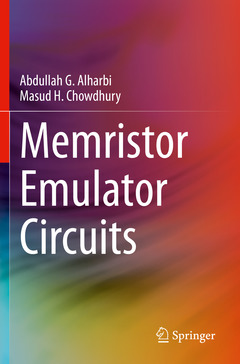Memristor Emulator Circuits, 1st ed. 2021
Auteurs : Alharbi Abdullah G., Chowdhury Masud H.

This book provides a comprehensive study of the research outcomes on memristor emulator circuits and includes various analog applications as examples. The authors describe in detail how to design different types of memristor emulators, using active and passive components for different applications. Most of the emulator circuits presented in this book are new and are the outcomes of the authors? recent research. Coverage also includes the latest technological advances in memristor and memristor emulators. Readers will benefit from an understanding of the fundamental concepts and potential applications related to memristors, since these emulator circuits can be built in the laboratory using inexpensive, off-the-shelf circuit components.
- Introduces readers to memristor emulator circuit design, using regular off-the-shelf circuit components;
- Describes analog applications of memristors that can be verified by the proposed emulator circuits;
- Includesa brief overview of the updated mathematical models of the memristor device, with different material implementations;
- Equips readers to understand the three fingerprints of memristors, which make them unique, compared to the three known, passive elements (resistor, inductor and capacitor).
Memristor Theory And Concepts.- Memresistive Devices.- Spin Based And Magnetic Memristive Systems.- Memristor Spice Model.- Current-Controlled Memristor Emulations.- Simple Current–Controlled Memristive Emulators.- Voltage-Controlled Memristor Emulations.- Simple Flux–Controlled Memristive Emulators.- Analog And Digital Modulation Using Memristor.- Conclusion and Future Work.
Dr. Abdullah G. Alharbi received the B.Sc. degree in electronics and communications engineering in 2010 from Qassim University, Saudi Arabia. He got his MS and Ph.D. degrees in Electrical and Computer Engineering in 2014 and 2017, respectively, from the University of Missouri - Kansas City (UMKC). Currently, he is an Assistant Professor in the Department of Electrical Engineering at Al Jouf University of Saudi Arabia. From 2010 to 2012, he worked in Saudi Aramco Company as an Electrical Engineer. He authored ~15 journal and conference papers and book chapters. He is a member of IEEE, IEEE Circuits and Systems Society, IEEE Young Professionals, IEEE Signal Processing Society, IEEE Instrumentation and Measurement Society, ACM, and Gulf Engineering Union. His research interests include digital IC design, memristor, and emerging memory devices.
Dr. Masud H Chowdhury received the B.Sc. degree in electrical and electronic engineering from Bangladesh University of Engineering and Technology (BUET), Dhaka in 1998 and the Ph.D. degree in computer engineering from Northwestern University, Evanston, Illinois, USA in 2004. Currently, he is the Associate Dean of the School of Computing and Engineering and a Professor in the Department of Computer Science Electrical Engineering at UMKC. He has published more than 170 articles in various journals and conferences in the fields of microelectronics and nanotechnology. Dr. Chowdhury has served as the Chair of the IEEE VLSI Systems and Applications Technical Committee from 2014 to 2016. He has been serving in the Editorial Boards of IEEE TCAS II, IEEE TVLSI, IEEE JETCAS, Springer Journal of Circuit, Systems, and Signal Processing, and Elsevier Microelectronics Journal. He has also been serving the professional community as the symposium chair, conference track chair, special session organizer, review committee chair, session chair, and many other roles for the last 15 years. He has supervised more than 60 Ph.D. and MS students aDate de parution : 09-2021
Ouvrage de 103 p.
15.5x23.5 cm
Date de parution : 09-2020
Ouvrage de 103 p.
15.5x23.5 cm



